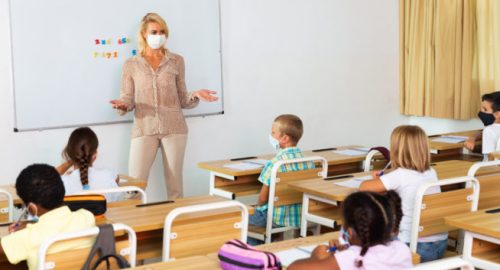In March 2020, the U.S. Congress passed the Coronavirus Aid, Relief and Economic Security (CARES) Act in response to the pandemic. CARES included approximately $13.2 billion for The Elementary and Secondary School Emergency Relief (ESSER) Fund.
The Coronavirus Response and Relief Supplemental Appropriations (CRRSA) Act, signed into law in December 2020, provides an additional $54.3 billion in an ESSER II Fund.
In March 2021, President Biden signed the American Rescue Plan (ARP) Act into law. This act includes the American Rescue Plan Elementary and Secondary School Emergency Relief (ARP ESSER) Fund, which allocates $126 billion for K-12 schools.
| CARES Act | CRRSA Act | ARP Act |
|---|---|---|
| Signed Into Law March 2020 | Signed Into Law December 2020 | Signed Into Law March 2021 |
| $13.2 billion for K-12 schools | $54 billion for K-12 schools | $126 billion for K-12 schools |
COVID-19 relief plans include over $193 billion for K-12 schools to address the pandemic and safely reopen
Each ESSER fund (ESSER, ESSER II, and ARP ESSER) must be used to address the impact COVID-19 has had and continues to have on elementary and secondary schools. Below we discuss the critical differences between each fund, how districts receive funding, and how they can use their funds to safely reopen.
Comparing Each ESSER Fund
The table below highlights the primary differences between each of the ESSER programs.
| Topic | ESSER Fund (2020 CARES) | ESSER II Fund (2021 CRRSA) | ARP ESSER (2021 ARP Act) |
|---|---|---|---|
| Deadline to Use Funds | Funds must be used by September 30, 2021. These funds can be used for costs dating back to March 13, 2020. | Funds must be used by September 30, 2022. These funds can be used for costs dating back to March 13, 2020. | Funds must be used by September 30, 2023. These funds can be used for costs dating back to March 13, 2020. |
| SEA Deadline for Awarding Funds to LEAs | The SEA must award the funds within one year of receiving them. The specific date varies with each SEA, but will fall between April through June 2021. | SEA must award the funds by January 2022, which will be one year from when they received the funds. | SEA must allocate ARP ESSER funds to LEAs no later than 60 days after the SEA receives funds. |
| SEA Requirements for Using Funds | No percentage requirements. | SEAs can keep about 12% of the funding and must spend at least 5% on learning loss, 1% on summer learning, and 1% on afterschool programs. | |
| LEA Requirements for Using Funds | No percentage requirements. | An LEA must reserve at least 20% of funds to address learning loss through the implementation of evidence-based interventions (summer learning, extended day or afterschool programs). These programs must respond to studentsacademic, social, and emotional needs and address the disproportionate impact of COVID-19 on underrepresented student Subgroups. The remaining ARP ESSER funds may be used for the same purchases allowed under ESSER and ESSER II. |
|
| Reopening Plans | No requirements for establishing a reopening plan. | Within 30 days of receiving funds, the LEA must publish on its website a plan for the safe return to in-person instruction and continuity of services. Before making the plan publicly available, the LEA must seek public comment on the plan. | |
| Non-Public Schools (Equitable Services) | An LEA that receives ESSER funding must provide equitable services to non-public school students and teachers. | LEAs are not required to provide equitable services. This Act has a separate program (Emergency Assistance for Non-Public Schools) that allows non-public schools to apply to an SEA and receive services. | LEAs are not required to provide equitable services. The ARP includes the Emergency Assistance for Non-Public Schools. |
Receiving Your Funds
The U.S. Department of Education has distributed ESSER and ESSER II funds directly to the state education agencies (SEAs). The Department will begin distributing ARP ESSER funds in March 2021.
School districts must apply to their states SEADepartment of Education or Office of Public Instructionto receive their funding. You can see the funding each state received here:
Each SEA will have its own process, so it is imperative you continue to monitor your states SEA for information on the steps needed to receive funding.
Using ESSER Funds
Districts must use the funds to address COVID-19’s impact on K-12 schools. This includes items such as:
- investing in resources to implement CDC’s K-12 operational strategy for in-person learning to keep educators, staff, and students safe
- developing and implementing procedures and systems to prepare for reopening and to improve your response efforts, including contact tracing efforts and recording visitor temperatures
- purchasing technology to support students and staff
- implementing strategies to meet the social, emotional, mental health, and academic needs of students hit hardest by the pandemic
- planning for and coordinating long-term closures
- providing principals and school leaders with funds needed for their individual school needs
- addressing learning loss by hiring additional educators and funding crucial summer, afterschool, and other extended learning and enrichment programs.
- repairing and upgrading buildings to improve air quality
- other necessary activities to maintain the operation of and continuity of services
Committed Ally for Your COVID-19 Response Efforts
Raptor software helps schools across the country address COVID-19s impact so that they can focus on reopening and keeping their students, staff, and communities safe. Raptor helps schools maintain operations during closures, facilitate contact tracing, and screen students, staff, and visitors for COVID-19 exposure. Our health screening software is being used in over 4,000 schools and has screened students over one million times, staff over 471K times, and visitors over 426K times since July 2020.
For more information on how Raptor can help you respond to COVID-19, click here to schedule a personalized demo.





